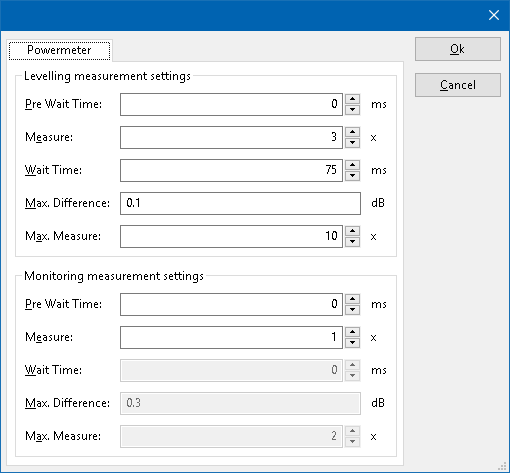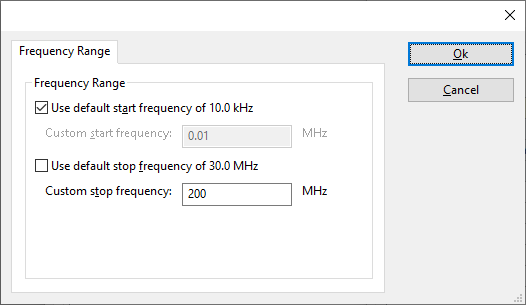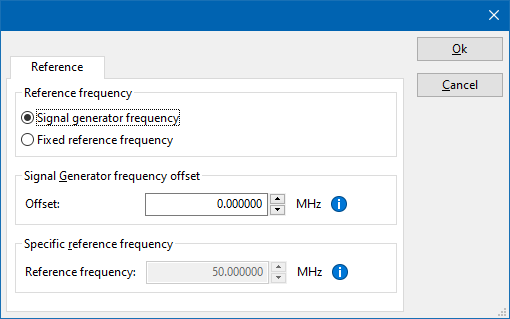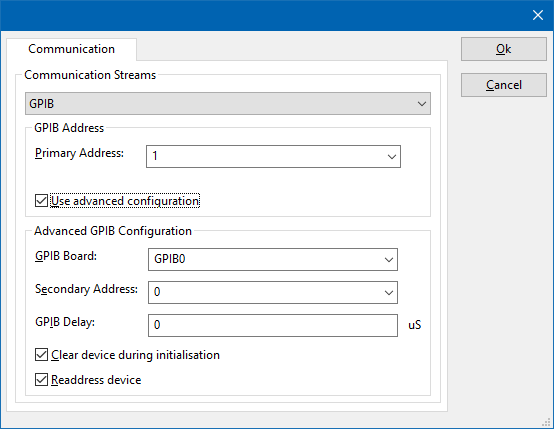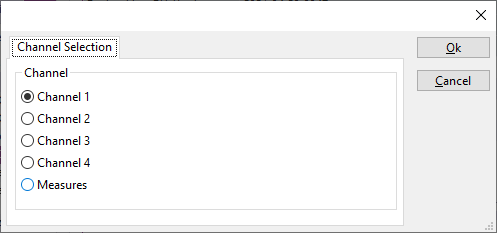LeCroy 9310C Channel A: Difference between revisions
(Updated DeviceDriverInfo template) |
No edit summary |
||
| (176 intermediate revisions by 2 users not shown) | |||
| Line 2: | Line 2: | ||
|DLLFile=RADAD.DLL | |DLLFile=RADAD.DLL | ||
|DeviceBrand=LeCroy | |DeviceBrand=LeCroy | ||
|DeviceDriverName= | |DeviceDriverName=LECROY9310ALPOWER_CHA | ||
|DeviceType=9310C Channel A | |DeviceType=9310C Channel A | ||
|SupportedDeviceTypes= | |SupportedDeviceTypes=72 | ||
|HideAutoData=1 | |||
}} | }} | ||
{{:LeCroyOscilloscopeDeviceDriverConfiguration}} | |||
Latest revision as of 08:51, 20 April 2021
The LeCroy 9310C Channel A device driver is a Power Meter, AD Converter which is supported by RadiMation®.
Configuration[edit]
The following tabs are available in the advanced configuration of the LeCroy 9310C Channel A:
| Wait time before starting the measurement-loop. Can be used to wait for a signal generator, and or amplifier to stabilize. |
| The minimum amount of measurements in the measure loop. Continues to loop even if power level is stable. |
| The wait time between each measurement is taken, during the measurement-loop. |
| If the measured power between each measurement in the measurement-loop, is less than this value. The measured power is stable. The measurement-loop will then stop. |
| The maximum amount of measure times, for the measurement-loop |
According to these settings, RadiMation® will perform a minimum of 3 power measurements with a wait time between the measurements of 75ms. If all those 3 measurements are within 0.1 dB, the power measurement is assumed to be stable, and RadiMation® will continue to average of the last 3 measurements. If the difference between the measurements is larger than the specified 0.1 dB, an additional power measurement will be performed, and the last 3 samples will be compared to the 0.1 dB difference again. At most 10 measurements will be performed if the difference between the 3 samples will not be within the specified 0.1 dB.
Both for the leveling, and the monitoring these settings can be set individually. The leveling is used, whenever RadiMation® is measuring the power, to regulate the signal generator. If the powermeter is only used as input, without regulating on it, then the monitoring settings are used.
More detailed information on how to achieve a fast and stable power measurement is available in Application Note 106: Powermeter parameter configuration.
The frequency range of the LeCroy 9310C Channel A as provided by the manufacturer is shown and selected as default. It is possible to overrule these frequencies and to manually adjust the allowed frequency range of the LeCroy 9310C Channel A.
| If the checkbox is checked, the default start frequency will be used as the lowest usable frequency in a test for this device. |
| If the Use default start frequency checkbox is unchecked, another start frequency (expressed in MHz) can be specified. The customized start frequency will then be used as the lowest usable frequency in a test for this device. The customized frequency can be a limitation or an extension of the default start frequency. |
| If the checkbox is checked, the default stop frequency will be used as the highest usable frequency in a test for this device. |
| If the Use default stop frequency checkbox is unchecked, another stop frequency (expressed in MHz) can be specified. The customized stop frequency will then be used as the highest usable frequency in a test for this device. The customized frequency can be a limitation or an extension of the default stop frequency. |
Specifying a different frequency range can be useful if for example:
- A device (like a coupler, antenna, injection device, cable, etc...) is still usable (but out of specification) outside the standard suggested frequency range.
- An external mixer is used to measure an extended frequency range.
- An up- or down-convertor is used to shift the frequency range.
- A newer model of a device is present that has an extended frequency range, and still uses the same remote control commands.
Be careful changing these settings as RadiMation® is no longer able to verify if the LeCroy 9310C Channel A is used outside frequency range that is specified by the manufacturer. This may result in serious damage to your measurement device.
The settings on the Reference tab influence the measurement frequency that is communicated to the measurement device. The frequency that is forwarded to the measurement device can for example be used by the device to perform the measurement on the correct frequency, or use the correct internal frequency dependant correction or calibration factor on the measurement result. Normally it is desired that the measurement frequency is the same as the carrier frequency of the signal generator. In some situations it can however be required to communicate a different frequency to the measurement device. In such a situation the settings on the Reference tab can be modified.
| Selects that the actual carrier frequency of the signal generator is communicated to the measurement device. This is the default behaviour. |
| Selects that a fixed frequency (independent of the signal generator carrier frequency) is communicated to the measurement device. |
| An additional offset frequency specified in MHz, that is added to frequency that is communicated to the measurement device. This value can be positive or negative, and defaults to 0.0 MHz. |
| The fixed reference frequency specified in MHz that is communicated to the measurement device, when the Fixed reference frequency option is selected. |
| Warning: | When a different reference frequency is specified and communicated to the measurement device, it is only relevant for the measurement device. A correction file that is attached to the device driver in RadiMation® will still use the correction value that is specified for the actual signal generator carrier frequency. |
The following tabs are available in the advanced configuration of the LeCroy 9310C Channel A:
On the Communication tab, the desired communication method can be selected and configured. Depending on the selected method, additional relevant settings are shown and can be configured.
| Selects the medium or method that should be used to communicate with the device. Depending on the capabilities of the device this can be one or more of:
Depending on the selected communication stream, additional configuration parameters can be configured. See the Communication Settings in Chapter 15, on how to configure each of these communication streams. |
On the Channel Selection tab, the desired channel that should be measured can be selected.
| Channel 1 will be used as the measurement input. |
| Channel 2 will be used as the measurement input. |
| Channel 3 will be used as the measurement input. |
| Channel 4 will be used as the measurement input. |
| The 'Measures' as they can be configured on the LeCroy oscilloscope will be used. |
Some LeCroy oscilloscope devices only have 2 input channels, and in that case the configuration dialog will only show the channels that are supported.
Channel[edit]
If one of the Channel options is selected, the EUT Monitoring device in RadiMation® will use the following mapping:
| Channel | Measurement | Maximum value |
|---|---|---|
| 1 | Minimum amplitude | 353.55 V |
| 2 | Maximum amplitude | 353.55 V |
| 3 | Amplitude | 353.55 V |
| 4 | Peak to Peak voltage | 707.1 V |
| 5 | RMS value | 250 V |
| 6 | Frequency in MHz | 200 MHz |
| 7 | Dutycycle | 100 % |
| 8 | Trace dump |
The 'Trace dump' mode retrieves the trace data of the selected channel, and then creates a DUMP_<FREQ>MHz_<YEAR>-<MONTH>-<DAY>_<HOUR>-<MINUTE>-<SEC>.CSV file in the C:\Work\ directory that contains the raw data of the complete trace. The graph in RadiMation® thus doesn't show any logical information, however all the raw data of the traces is present in several files in the C:\Work\ directory.
Measures[edit]
If the Measures options is selected, the EUT Monitoring device in RadiMation® is retrieving the values from the 'Measure' that are configured in the LeCroy oscilloscope itself. The to be measured value can thus be configured in the LeCroy by using one of the available measurement functions. See the end-user manual of the LeCroy on how these 'Measures' can be configured. The measure configuration in the LeCroy also includes from which input channel the value should be measured. These measures are numbered in the LeCroy, and the same numbering is used in the RadiMation®. The EUT Monitoring channel 2 will thus use the value of Measure 2 in the LeCroy.
